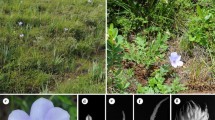matK
was conducted using 41 Trillium taxa and two out-group taxa (Veratrum maackii and Helonias bullata). A total of 1608 base pairs were analyzed and compared., and then there were 61 variable (36 informative) sites among Trillium species. Fifteen insertion/deletion events (indels) of six or fifteen base pairs were also detected. Phylogenetic analyses of the sequence data revealed that the subgenus Phyllantherum (sessile-flowered species) forms a distinct monophyletic group, whereas the subgenus Trillium (pedicellate-flowered species) does not form a monophyletic group, and is composed of three distinct groups and three basally located species in the tree: (1) the Erectum group, (2) the Grandiflorum group, and (3) the Pusillum group and (4) the three species, including T. govanianum, T. undulatum, and T. rivale. T .rivale appears to be the most basally diverged and a very specialized taxon among the ingroup members. Our matK data indicated that the closest relative of the subgenus Phyllantherum is the Grandiflorum group. The results are concordant with the results of the RFLP analysis of cpDNA and also more or less with those of the cladistic analysis of morphological characters.
Similar content being viewed by others
Author information
Authors and Affiliations
Additional information
Received 11 September 1998/ Accepted in revised form 25 December 1998
Rights and permissions
About this article
Cite this article
Osaloo, S., Utech, F., Ohara, M. et al. Molecular Systematics of Trilliaceae I. Phylogenetic Analyses of Trillium Using matK Gene Sequences. J Plant Res 112, 35–49 (1999). https://doi.org/10.1007/PL00013853
Issue Date:
DOI: https://doi.org/10.1007/PL00013853




